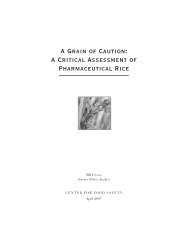a four-fold rise - Center for Food Safety
a four-fold rise - Center for Food Safety
a four-fold rise - Center for Food Safety
Create successful ePaper yourself
Turn your PDF publications into a flip-book with our unique Google optimized e-Paper software.
<strong>Center</strong> <strong>for</strong> <strong>Food</strong> <strong>Safety</strong> – Science Comments – FG72 Soybean <br />
43 <br />
Emergence of Glyphosate-Resistant Weeds in the U.S.: <br />
4th Q 2007 to 4th Q 2011 <br />
18,000,000 <br />
90 <br />
16,000,000 <br />
80 <br />
14,000,000 <br />
Acres Infested <br />
12,000,000 <br />
10,000,000 <br />
8,000,000 <br />
6,000,000 <br />
4,000,000 <br />
2,000,000 <br />
70 <br />
60 <br />
50 <br />
40 <br />
30 <br />
No. of Reports <br />
0 <br />
4th Q 1st Q 2nd Q 3rd Q 4th Q 1st Q 2nd Q 3rd Q 4th Q 1st Q 2nd Q 3rd Q 4th Q 1st Q 2nd Q 3rd Q 4th Q <br />
2007 2008 2008 2008 2008 2009 2009 2009 2009 2010 2010 2010 2010 2011 2011 2011 2011 <br />
20 <br />
Min. Acres Max. Acres No. of Reports Poly.(No. of Reports) <br />
Legend: This chart plots data on glyphosate-‐resistant weeds in the U.S. compiled from the International Survey of <br />
Herbicide-‐Resistant Weeds (ISHRW) as of December 31, 2011. See CFS GR Weed List (2012) <strong>for</strong> the data upon <br />
which this chart is based. The ISHRW lists reports of confirmed herbicide-‐resistant weeds submitted by weed <br />
scientists. 9 Each report normally contains the year of discovery, the number of sites and acreage infested by the <br />
resistant weed population, the crop or non-‐crop setting where the weed was found, whether or not the population <br />
is expanding, and date the report was last updated. Note that months to several years can elapse be<strong>for</strong>e a <br />
putative resistant weed population is confirmed as resistant and listed on the website. ISHRW reports sites and <br />
acreage infested in ranges due to the difficulty of making precise point estimates. CFS aggregated ISHRW data <strong>for</strong> <br />
all glyphosate-‐resistant weed reports on ten dates – 11/21/07, 2/2/09, 11/19/09, 2/25/10, 5/18/10, 11/30/10, <br />
1/6/11, 7/5/11, 9/28/11 and 12/31/11 – corresponding to the ten bars in the graph above. The bars were <br />
assigned to the appropriate quarterly period on the x-‐axis. The minimum and maximum acreage values represent <br />
the aggregate lower-‐ and upper-‐bound acreage infested by all glyphosate-‐resistant weeds listed by ISHRW on the <br />
given date. The number of reports is plotted on the secondary y-‐axis. ISHRW organizer Dr. Ian Heap made a point <br />
estimate of 10.4 million acres infested with GR weeds in May of 2010, 10 when the maximum acreage infested was <br />
11.4 million acres. This suggests that the upper-‐bound estimates more closely approximate real world conditions. <br />
However, many reports of glyphosate-‐resistant weeds in the farm press and scientific literature are never <br />
9 Each report may be accessed by (and corresponds to) a link at: <br />
http://www.weedscience.org/Summary/UspeciesMOA.asp?lstMOAID=12&FmHRACGroup=Go. <br />
10 “WSSA supports NRC Findings on Weed Control,” Weed Science Society of America, 5/27/10. Dr. Heap is cited <br />
<strong>for</strong> the statement that 6% of total area planted to soybean, soybean and cotton in the U.S. [which is 173 million <br />
acres] is infested with GR weeds. <br />
http://www.wssa.net/WSSA/In<strong>for</strong>mation/WSSA%20position%20paper%20on%20herbicide%20resistance%20<br />
5-‐27-‐2010.pdf.







